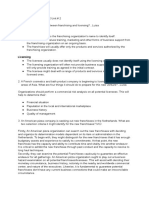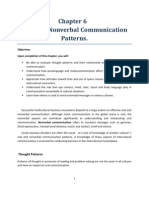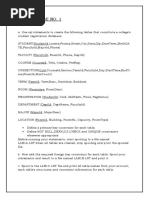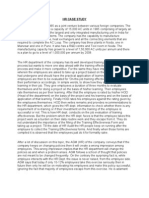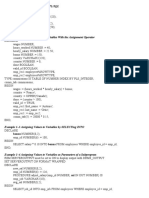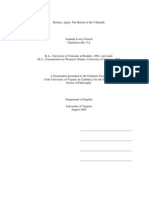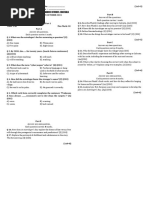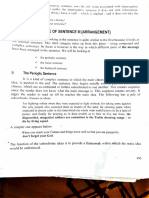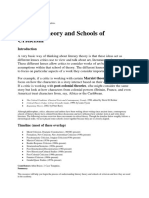Hop
Hop
Uploaded by
Mindy KennedyCopyright:
Available Formats
Hop
Hop
Uploaded by
Mindy KennedyOriginal Description:
Copyright
Available Formats
Share this document
Did you find this document useful?
Is this content inappropriate?
Copyright:
Available Formats
Hop
Hop
Uploaded by
Mindy KennedyCopyright:
Available Formats
--Create a PL/SQL block to declare a cursor to select last name, first name, salary, and hire date from
the EMPLOYEE table. -Retrieve each row from the cursor and print the employees information if the employees salary is greater than $50,000 and the hire date is before 31-DEC1997 (explicit cursor problem). OUTPUT: Smith, John makes $265000 Hired: 15-APR-60 Houston, Larry makes $150000 Hired: 19-MAY-67 Roberts, Sandi makes $75000 Hired: 02-DEC-91 McCall, Alex makes $66500 Hired: 10-MAY-97 Dev, Derek makes $80000 Hired: 15-MAR-95 PL/SQL procedure successfully completed.
--Create a PL/SQL block that declares a cursor. -Pass a parameter to the cursor of the type that is the same as the Salary column in EMPLOYEE table to the cursor. Open the cursor with a value for the parameter. -Retrieve information into the cursor for a salary higher than the parameter value. -Use a loop to print each employees information from the cursor (cursor with parameter problem). OUTPUT: Enter value for v_salary: 75000 Smith, John makes $265000 Houston, Larry makes $150000 Dev, Derek makes $80000 PL/SQL procedure successfully completed.
--Create a PL/SQL block to increase salary of employees in department 10. -The salary increase is 15% for the employees making less than $100,000 and 10% for the employees making $100,000 or more. -Use a cursor with a FOR UPDATE clause. -Update the salary with a WHERE CURRENT OF clause in a cursor FOR loop (cursor FOR loop problem).
DECLARE CURSOR empcur IS SELECT Lname, Fname, Salary, HireDate FROM employee; last employee.Lname%TYPE; first employee.Fname%TYPE; sal employee.Salary%TYPE; hire employee.HireDate%TYPE; BEGIN OPEN empcur; FETCH empcur INTO last, first, sal, hire; WHILE empcur%FOUND LOOP IF sal > 50000 AND hire < '31-DEC-1997' THEN DBMS_OUTPUT.PUT(last||', '||first||' makes $'||sal); DBMS_OUTPUT.PUT_LINE(' Hired: '||hire); END IF; FETCH empcur INTO last, first, sal, hire; END LOOP; CLOSE empcur; END; DECLARE CURSOR empcur (sal employee.Salary%TYPE) IS SELECT Lname, Fname, Salary FROM employee WHERE Salary > sal; sal_param employee.Salary%TYPE := &v_salary; last employee.Lname%TYPE; first employee.Fname%TYPE; sal employee.Salary%TYPE; BEGIN OPEN empcur (sal_param); FETCH empcur INTO last, first, sal; WHILE empcur%FOUND LOOP DBMS_OUTPUT.PUT_LINE(last||', '||first||' makes $'||sal); FETCH empcur INTO last, first, sal; END LOOP; CLOSE empcur; END; DECLARE CURSOR emp_cur IS SELECT EmployeeId, SALARY FROM employee WHERE DeptId = 10 FOR UPDATE; incr NUMBER; BEGIN FOR emp_rec IN emp_cur LOOP IF emp_rec.Salary < 100000 THEN incr := 0.15; ELSE incr := 0.10; END IF; UPDATE employee SET Salary = Salary + Salary * incr WHERE CURRENT OF emp_cur; END LOOP; END; DECLARE first employee.Fname%TYPE; last employee.Lname%TYPE; qual employee.QualId%TYPE; Sal employee.Salary%TYPE; v_qualId employee.QualId%TYPE := &Qualification_Id; BEGIN SELECT Lname, Fname, QualId, Salary INTO last, first, qual, sal FROM employee WHERE QualId = v_qualId; DBMS_OUTPUT.PUT_LINE(last || ', ' || first); DBMS_OUTPUT.PUT_LINE('Qualification: ' || qual); DBMS_OUTPUT.PUT_LINE('Salary: ' || sal); EXCEPTION WHEN NO_DATA_FOUND THEN DBMS_OUTPUT.PUT_LINE ('No employees with such qualification'); WHEN TOO_MANY_ROWS THEN DBMS_OUTPUT.PUT_LINE ('More than employee with qualification ' || v_qualId); END;
--Write a PL/SQL block to retrieve employees from the EMPLOYEE table based on a qualification Id. -If the qualification Id returns more than one row, handle the exception with the appropriate handler and print the message More than one employee with such qualification. -If the qualification Id returns no employee, handle the exception with the appropriate handler and display the message No employees with such qualification. -If the qualification Id returns one employee, then print that employees name, qualification and salary (predefined server exception problem). OUTPUT: Enter value for qualification_id: 7 No employees with such qualification PL/SQL procedure successfully completed. SQL> / Enter value for qualification_id: 1 More than employee with qualification 1 PL/SQL procedure successfully completed. SQL> / Enter value for qualification_id: 5 Garner, Stanley Qualification: 5 Salary: 45000 PL/SQL procedure successfully completed. --PROCEDURES: FIRST Example CREATE OR REPLACE PROCEDURE DEPENDENT_INFO IS CURSOR DEP_CUR IS SELECT LNAME, FNAME, COUNT(DEPENDENTID) CNT FROM EMPLOYEE E, DEPENDENT D WHERE E.EMPLOYEEID = D.EMPLOYEEID GROUP BY LNAME, FNAME; BEGIN FOR DEP_REC IN DEP_CUR LOOP IF DEP_REC.CNT >= 2 THEN DBMS_OUTPUT.PUT_LINE(DEP_REC.LNAME || ',' || DEP_REC.FNAME. || 'HAS || D); END IF;
END LOOP; END;
You might also like
- 434 HW 2 SolDocument5 pages434 HW 2 SolAnhTuan NguyenHuuNo ratings yet
- Airbus A380 A Risk Management Framework - Unpublishedwork PDFDocument48 pagesAirbus A380 A Risk Management Framework - Unpublishedwork PDFSumanth ShettyNo ratings yet
- Chapter1 SolutionsDBDocument3 pagesChapter1 SolutionsDBapi-374334580% (5)
- IM Ch05 Advanced Data Modeling Ed9Document20 pagesIM Ch05 Advanced Data Modeling Ed9msalmohaya33% (12)
- Case AnalysisDocument12 pagesCase Analysisasusf6ve0% (1)
- Jim Manzano Is The General Partner of An Investment GroupDocument1 pageJim Manzano Is The General Partner of An Investment GroupAmit PandeyNo ratings yet
- Tugas Simulasi Sistem Industri MUHAMMAD ARIO - D071171516Document3 pagesTugas Simulasi Sistem Industri MUHAMMAD ARIO - D071171516Ergi Zair0% (1)
- Individual Case Study Assignment On Chapter Five-OBDocument3 pagesIndividual Case Study Assignment On Chapter Five-OBDawit Asmelash0% (1)
- Practice 1 To 15 and AnswersDocument47 pagesPractice 1 To 15 and Answersmalik baidarNo ratings yet
- Kajian IE - WA BankDocument6 pagesKajian IE - WA BankVasant SriudomNo ratings yet
- Case 1 WalmartDocument2 pagesCase 1 Walmartijustateanapple100% (2)
- Mrketing Assignment 2 - Netflix - 5!6!920190412180106Document6 pagesMrketing Assignment 2 - Netflix - 5!6!920190412180106DrMayank Ranjan SrivastavaNo ratings yet
- Competing Within A Changing World - Rolls Royce CaseDocument7 pagesCompeting Within A Changing World - Rolls Royce CasePiyush Bhut100% (1)
- FranchisingDocument2 pagesFranchisingJoel Christian MascariñaNo ratings yet
- Chapter 5 NotesDocument4 pagesChapter 5 NotesAgithaNo ratings yet
- Chapter 5 AnswersDocument3 pagesChapter 5 Answersapi-4798026050% (1)
- Answer 9Document8 pagesAnswer 9postscript50% (2)
- Oral An Nonverbal CommunicationDocument25 pagesOral An Nonverbal CommunicationNino Rachvelishvili0% (1)
- Chap 3 AnswersDocument3 pagesChap 3 Answersnarender_singh_62100% (2)
- Johns 10e Irm ch09Document42 pagesJohns 10e Irm ch09Jacob WeiseNo ratings yet
- Lab Exercise No1Document13 pagesLab Exercise No1Lippe Aizen100% (2)
- Samima Mam AssignmentDocument6 pagesSamima Mam AssignmentMasudHimelNo ratings yet
- Self-Assessment CHP 3Document2 pagesSelf-Assessment CHP 3Evi DamayantiNo ratings yet
- Systems Network Architecture (SNA)Document23 pagesSystems Network Architecture (SNA)Sean Matthew L. Ocampo0% (1)
- Case Study For HdbmsDocument5 pagesCase Study For HdbmsMohammed ABDO ALBAOMNo ratings yet
- Case StudyDocument2 pagesCase StudyasadNo ratings yet
- Portman HRMTDocument5 pagesPortman HRMTSayakBiswasNo ratings yet
- M.E (Or) QBDocument21 pagesM.E (Or) QBkeerthi_sm180% (1)
- FMB&TDocument3 pagesFMB&Tpriam gabriel d salidaga100% (1)
- HR Case StudyDocument2 pagesHR Case Studyvuthaiha100% (1)
- Div F Group 5 HRM Movie ReviewDocument8 pagesDiv F Group 5 HRM Movie ReviewVaibhav AroraNo ratings yet
- Multiple Choice 20 20: Question Type: # of Questions: # CorrectDocument3 pagesMultiple Choice 20 20: Question Type: # of Questions: # CorrectAadil PirvaniNo ratings yet
- Organizational Behavior and IBMDocument5 pagesOrganizational Behavior and IBMRahul Durgia100% (1)
- Chapter 3Document4 pagesChapter 3titanchengNo ratings yet
- Portman CaseDocument9 pagesPortman CaseDivya Naik100% (1)
- CASE 4 - Otis Elevator and 360-Degree Feedback On The InternetDocument1 pageCASE 4 - Otis Elevator and 360-Degree Feedback On The InternetAsh LyNo ratings yet
- End of Module Project. Human Resource Management September 2020 ADocument11 pagesEnd of Module Project. Human Resource Management September 2020 Asebastian luthNo ratings yet
- Production Decisions at Harding Silicon Enterprises Inc Answer.Document4 pagesProduction Decisions at Harding Silicon Enterprises Inc Answer.chunghsin0305No ratings yet
- Normalization in DBMS - 1NF, 2NF, 3NF and BCNF in DatabaseDocument6 pagesNormalization in DBMS - 1NF, 2NF, 3NF and BCNF in Databaseanon_9457842650% (2)
- Assignment One Human Resource Management (MGT211) Deadline: 06/03/2021 at 23:59Document4 pagesAssignment One Human Resource Management (MGT211) Deadline: 06/03/2021 at 23:59habibNo ratings yet
- SQL - Practice AssignmentsDocument3 pagesSQL - Practice AssignmentsJaganathan SekarNo ratings yet
- Ch19 Aggregate PlanningDocument3 pagesCh19 Aggregate Planningnurul_azizah01No ratings yet
- Appraising The Secretaries of Sweet Water UniversityDocument4 pagesAppraising The Secretaries of Sweet Water UniversityZain4u100% (1)
- Database Management SystemDocument60 pagesDatabase Management SystemÐipänzän 'rocky' ZärkärNo ratings yet
- HRMSDocument20 pagesHRMSMohammed AminNo ratings yet
- Midterm Solution AEM 805Document11 pagesMidterm Solution AEM 805Adefemi100% (1)
- c05 Net ModelsDocument55 pagesc05 Net ModelsRaunak TimilsinaNo ratings yet
- Chapter5 Example ExerciseDocument7 pagesChapter5 Example ExerciseElisaNo ratings yet
- Dbms Lab Assignment 3newDocument15 pagesDbms Lab Assignment 3newNilesh kumar kamalNo ratings yet
- Practice 4Document3 pagesPractice 4Morales MeowNo ratings yet
- PLSQLDocument8 pagesPLSQLojaswigahoi2022No ratings yet
- Example 1-1 Declaring Variables in PL/SQL: Bonus NUMBER (8,2)Document23 pagesExample 1-1 Declaring Variables in PL/SQL: Bonus NUMBER (8,2)Brijesh SinghNo ratings yet
- DBMS LABDocument15 pagesDBMS LABAbhinav KoraNo ratings yet
- ad3391 LAB MANUALDocument23 pagesad3391 LAB MANUALhamsadineshkumarNo ratings yet
- Rdbms and SQL: Name:Ibrahim Sameer V S REG NO:17BCA0062Document33 pagesRdbms and SQL: Name:Ibrahim Sameer V S REG NO:17BCA0062Mahi Sameer100% (1)
- Rdbms LabDocument5 pagesRdbms Labafrin nishaNo ratings yet
- Database All Queries of MID TERMDocument7 pagesDatabase All Queries of MID TERMtarekms008No ratings yet
- Dbms Lab NoteDocument4 pagesDbms Lab Notebiswajitparida514No ratings yet
- Assignment1 - 94089Document12 pagesAssignment1 - 94089amrsalatifNo ratings yet
- Assn2Fall2010 SolutionDocument11 pagesAssn2Fall2010 SolutionAlexander LionheartNo ratings yet
- Oracle Flexcube ImplementionDocument84 pagesOracle Flexcube ImplementionKhaledNo ratings yet
- PLSQL 4 5Document12 pagesPLSQL 4 5ssmileNo ratings yet
- Figurative LanguageDocument3 pagesFigurative LanguageKarla Bernadette LugtuHonrado GonzalesNo ratings yet
- DS-2CD3B86G2T-IZHSY-C - Datasheet - V5.7.3 - 20220119 Bullet CNCHDocument7 pagesDS-2CD3B86G2T-IZHSY-C - Datasheet - V5.7.3 - 20220119 Bullet CNCHJesus PradoNo ratings yet
- Week 1 Bahasa Inggris Study ProjectDocument29 pagesWeek 1 Bahasa Inggris Study ProjectMuhammad rezky pratamaNo ratings yet
- Developing-Literacy Sentence-Activities Book-C Lower FinalDocument66 pagesDeveloping-Literacy Sentence-Activities Book-C Lower Finalcalvinsong.ozNo ratings yet
- Cop Marat IveDocument9 pagesCop Marat IveKhalil HawatmahNo ratings yet
- Lesson Plan 1 Year 2 Task 1Document8 pagesLesson Plan 1 Year 2 Task 1g-p21212121No ratings yet
- DE2i-150 User Manual Vo.04Document111 pagesDE2i-150 User Manual Vo.04Lucas CambuimNo ratings yet
- LecturesQM 1Document21 pagesLecturesQM 1vad filhoNo ratings yet
- Refrain, Again: The Return of The VillanelleDocument284 pagesRefrain, Again: The Return of The VillanelleAmanda French100% (1)
- Booklet 6toDocument58 pagesBooklet 6toGaby ArredondoNo ratings yet
- Viii-India in The 18th Century-P-IDocument3 pagesViii-India in The 18th Century-P-Iphooldas851No ratings yet
- Buchla Music Easel ManualDocument68 pagesBuchla Music Easel Manualchloe_stamperNo ratings yet
- Cetpa IOT TrainingDocument1 pageCetpa IOT TrainingSheetal kondelNo ratings yet
- MYP 2 Online Unit PlanDocument40 pagesMYP 2 Online Unit PlanYomna SherifNo ratings yet
- English Year 3 Assessment Unit 9,10Document8 pagesEnglish Year 3 Assessment Unit 9,10SITI HANISAH BINTI MUHAMMAD ADIL MoeNo ratings yet
- Scan With Roll UpDocument3 pagesScan With Roll UpSreenivas YadavNo ratings yet
- Passive Voice: Form of Passive Subject + Object + To Be + Past Participle + Verb 3Document3 pagesPassive Voice: Form of Passive Subject + Object + To Be + Past Participle + Verb 3SoniaNo ratings yet
- 1st Sem English BCA &BSCDocument2 pages1st Sem English BCA &BSCshibla kkNo ratings yet
- Types of Sentences III (Arrangements)Document2 pagesTypes of Sentences III (Arrangements)clawsrafNo ratings yet
- Quality Control Plan Static EquipmentDocument1 pageQuality Control Plan Static EquipmentdhasdjNo ratings yet
- Literary Theory and Schools of CriticismDocument18 pagesLiterary Theory and Schools of CriticismMęawy MįlkshãkeNo ratings yet
- The Development of The Syntax of Post-Biblical HebrewDocument224 pagesThe Development of The Syntax of Post-Biblical HebrewOsmario Batista da Silva JuniorNo ratings yet
- Taller de Refuerzo Zero ConditionalDocument1 pageTaller de Refuerzo Zero ConditionalAdrian PancheNo ratings yet
- Byrne 2001Document3 pagesByrne 2001warface98No ratings yet
- R Markdown File MidDocument13 pagesR Markdown File MidzlsHARRY GamingNo ratings yet
- TOEFL ExerciseDocument9 pagesTOEFL ExerciseNila HuniNo ratings yet
- Soal Us B.ing BN 2023Document10 pagesSoal Us B.ing BN 2023Raden Ali Ma'sumNo ratings yet
- Plato - The Myth of ErDocument16 pagesPlato - The Myth of ErPrashanth JanardhanNo ratings yet













